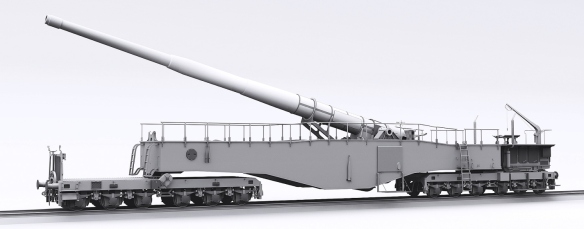
Damian Milas online portfolio
The K5(E) battery with one gun was transported with two separate trains.
The ‘gun train’ consisted of the following: 1 locomotive 1 K5(E) gun 1 ventilated ammunition car 1 diesel switching locomotive [Orenstein-Koppel model C14 diesel] for moving elements into position 2 shell cars each carried 113 shells 2 propellant charge cars 1 equipment car with small tools and supplies 1 armored rail car for defense of the gun crew using small arms 1 kitchen and supply car 1 fire control car-blast proof 1 flat car with 2cm Flakvierling 38 for air defense 3 buses for reconnaissance and supply units
The ‘turn-table’ train consisted of the following: 1 locomotive 1 car for each section of the 29.46 meter diameter turntable 1 car carrying 16 sections for the circular traverse track for the turntable and the construction crane 3 ammunition cars 1 equipment car with small tools and supplies 1 flat car with 2cm Flakvierling 38 for air defense 9 flat cars for carrying buses and other vehicles used by the battery.
More commonly known as “Anzio Annie” from one example’s use against Allied forces in the 1944 invasion of Italy, the 283mm K5 (E) was also known to the Germans as “Leopold.” Entering service in 1940, it weighed 480,607 pounds and mounted a horizontal sliding block and 802-inch-long barrel. Firing a special 561-pound splined shell, it had a maximum range of nearly 39 miles. The Germans fielded some twenty-five K5 (E)s during World War II, with one survivor now held at Aberdeen Proving Ground in Maryland and another in France.
The K5 (E) also provided the basis for a number of experimental weapons and projectiles that were developed at the Rocket Research Establishment at Peenemunde. There, German scientists developed a special rocket-assisted projectile fitted with a motor that ignited at the apex of its trajectory. Although the rocket boosted the projectile’s range to some 53 miles, its accuracy was poor, and the motor reduced the internal space available for its explosive charge. Another attempt to extend the gun’s range, the self-descriptive Peenemunde Arrow Shell, saw limited use in late 1944. Brilliant in concept yet poor in performance, the Arrow Shell was 70 inches long, guided by four fins, and had a 310mm driving band around its 120mm body. Fired from a 310mm smoothbore barrel at a velocity of 5,000 fps, the shell’s driving band dropped away after leaving the muzzle, giving it the astounding range of more than 90 miles. Although ultimately crippled by poor accuracy and a small explosive payload, most of the experimental guns saw at least some use during the war.